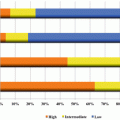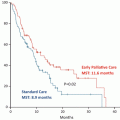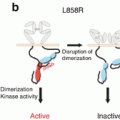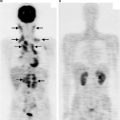Target
Agent
Study phase
Result
References
VEGF-A
Bevacizumab
II
Promising
[20]
II
Promising
[21]
II
Positive for PFS, but no benefit in OS
[22]
VEGFR-1, VEGFR-2, VEGFR-3
Cediranib
II
Negative
[23]
VEGFR, EGFR, RET
Vandetanib
II
Negative
[24]
VEGFR-2, VEGFR-3, PDGFR, BRAF, KIT, FLT3, RET
Sorafenib
II
Negative
[25]
VEGFR-1, VEGFR-2, VEGFR-3, PDGFR, KIT, FLT3, RET, CSF-1R
Sunitinib
II
Negative
[26]
II
Promising
[27]
II
Positive for PFS
[28]
VEGF-A, B
Ziv-aflibercept
II
Positive for PFS only in platinum-refractory patients
[30]
VEGFR, EGFR, RET
Thalidomide
III
Negative
[32]
III
Negative
[33]
MMPs
Marimastat
II
Negative
[36]
Bevacizumab
Bevacizumab, which is a humanized IgG1 monoclonal antibody targeting VEGF-A, showed the most promising results among VEGF-targeted agents. Although this agent, in combination with platinum-based chemotherapy, has been investigated in three phase II studies, the results were controversial.
A single-arm phase II study, Eastern Cooperative Oncology Group (ECOG) 3501, reported that the addition of bevacizumab to standard cisplatin and etoposide (EP) regimen followed by maintenance bevacizumab resulted in improved PFS and OS relative to historical controls who received EP regimen without bevacizumab: ORR of 63.5 %, 6 month PFS rate of 30.2 %, median PFS 4.7 months, and median OS of 10.9 months [20]. Another single-arm phase II study combining bevacizumab with carboplatin and irinotecan regimen reported more promising results, ORR of 84 % and median OS of 12.1 months [21]. A randomized phase II study, SALUTE, showed that the addition of bevacizumab to cisplatin or carboplatin plus etoposide regimen improved PFS (5.5 vs 4.4 months; HR: 0.53; 95 % CI, 0.32–0.86) with acceptable toxicity but failed to improve OS (9.4 vs 10.9 months, HR: 1.16; 95 % CI, 0.66–2.04) [22].
Cediranib
Cediranib is a potent and selective inhibitor of the VEGF receptors (VEGFR) 1, 2, and 3. A single-arm phase II study of cediranib for second-line therapy of SCLC reported that nine cases out of 25 had stable disease, but none had objective responses [23].
Vandetanib
Vandetanib is a multi-targeted kinase inhibitor of mainly VEGFR, epidermal growth factor receptor (EGFR), and RET-tyrosine kinases. A randomized phase II study (NCIC CTG BR.20) examined the improvement in PFS with vandetanib as maintenance therapy after objective responses to platinum-based chemotherapy with or without radiation therapy [24]. Vandetanib failed to prolong PFS, but limited-stage (LD) patients treated with vandetanib tended to have longer OS in planned subgroup analyses (HR: 0.45; p = .07).
Sorafenib
Sorafenib is a multi-targeted kinase inhibitor of VEGFR-2 and VEGFR-3, platelet-derived growth factor receptor (PDGFR), BRAF, KIT, FLT3, and RET. A single-arm phase II study (SWOG 0435) was conducted to evaluate the efficacy and safety of sorafenib in patients with SCLC who previously received platinum-based chemotherapy [25]. As the results were disappointing, the single-agent sorafenib was determined to be not recommended for SCLC.
Sunitinib
Sunitinib is a multi-targeted kinase inhibitor of VEGFR-1, VEGFR-2, and VEGFR-3, PDGFR, KIT, FLT3, RET, and colony-stimulating factor 1 receptor (CSF-1R). A single-arm phase II study was conducted to evaluate the efficacy and safety of sorafenib in previously treated patients with SCLC [26]. The efficacy was disappointing: ORR of 9 % (95 % CI, 1–28 %), median PFS 1.4 months (95 % CI, 1.1–1.7), and median OS 5.6 months (95 % CI, 3.5–7.7). Moreover, most of the patients were unable to tolerate sunitinib. Another single-arm phase II study evaluated the efficacy and safety of sunitinib as maintenance therapy following carboplatin and irinotecan regimen in patients with ED SCLC [27]. Sunitinib was well tolerated and showed encouraging results with 1-year OS of 54 % and median time to progression of 7.6 months.
A randomized phase II study (CALGB 30504, ALLIANCE) also evaluated the efficacy of maintenance sunitinib after cisplatin and etoposide regimen. Compared with placebo, sunitinib significantly improved PFS (2.1 vs 3.7 months; HR: 1.62; 95 % CI, 1.02–2.60, P = .02) [28]. The result supports the strategy of investigating the use of sunitinib in the maintenance setting and the future study.
Ziv-Aflibercept
Ziv-aflbercept is a recombinant fusion protein consisting of VEGF-binding portions from the extracellular domains of human VEGFR-1 and VEGFR-2 that are fused to the Fc portion of the human IgG1 immunoglobulin. The agent acts as a soluble decoy receptor that inhibits angiogenesis by targeting VEGF-A and VEGF-B [29]. A randomized phase II study (S0802) evaluated the efficacy of ziv-aflibercept with topotecan in patients with previously treated SCLC [30]. Ziv-aflibercept improved the 3-month PFS only in patients who had platinum-refractory SCLC (27 % v 10 %; P = .02) but increased toxicity. The addition of ziv-aflibercept to topotecan did not improve OS.
Thalidomide
Thalidomide, a glutamic acid derivative, inhibits angiogenesis by repression of key angiogenic genes and downregulation of VEGF and basic fibroblast growth factor [31, 32], while the mechanism is not fully understood. Two phase III studies have been conducted to evaluate the efficacy of thalidomide in patients with SCLC. An intergroup phase III study (FNCLCC cleo04 IFCT 00–01) failed to show survival benefit of adding thalidomide to platinum-based chemotherapy following response to induction chemotherapy (median OS, 11.7 vs 8.7 months; HR, 0.74; 95 % CI, 0.49–1.12, P = .16), but some benefit was observed among patients with a performance (PS) of 1 or 2 in exploratory analyses (HR, 0.59; 95 % CI, 0.37–0.92, P = .02) [32]. Moreover, sensory neuropathy occurred more frequently in the thalidomide group compared with the placebo group (33 % v 12 %, respectively). The other phase III trials evaluated thalidomide in combination with carboplatin and etoposide regimen [33]. The study also did not meet its primary endpoint of OS (10.5 vs 10.1 months; HR, 1.09; 95 % CI, 0.93–1.27, P = .28) and showed that thalidomide increased risk of thrombotic events.
8.2.1.2 MMP Inhibitors
Matrix metalloproteinases (MMPs) are a family of secreted proteins remodeling the extracellular matrix. The remodeling process is necessary for physiological events, such as wound repair, organismal growth and development, and mediation of immune responses. MMPs have been shown to contribute to angiogenesis and cell migration and found to be dysregulated in human cancers [34]. Overexpression of MMPs has been shown to correlate with poor prognosis in SCLC [35]. Therefore, MMPs has been proposed to be a potential target for treatment of SCLC.
Marimastat
Marimastat is a broad-spectrum MMP inhibitor. A phase III trial was conducted to evaluate efficacy of this agent as maintenance therapy after response to platinum-based chemotherapy in patients with SCLC [36]. Marimastat failed to improve survival (median PFS, 4.3 vs 4.4 months; HR, 0.977; 95 % CI, 0.807–1.184, P = .81; median OS, 9.3 vs 9.7 months; HR, 1.013; 95 % CI, 0.831–1.235, P = .90) and had a negative impact on quality of life.
8.2.2 Proliferative Signaling Pathways
The studied drugs targeting angiogenesis are listed in Table 8.2.
Table 8.2
Proliferative signaling pathway-targeted agents in SCLC
Target | Agent | Study phase | Result | References |
|---|---|---|---|---|
KIT, PDGFR, BCR-ABL | Imatinib | II | Negative | [38] |
II | Negative | [39] | ||
II | Negative | [40] | ||
II | Negative | [41] | ||
KIT, SRC, BCR-ABL | Dasatinib | II | Negative | [42] |
EGFR | Gefitinib | II | Negative | [43] |
MET | Rilotumumab | Ib/II | Ongoing | NCT00791154 |
IGF-1R | Ganitumab | Ib/II | Ongoing | NCT00791154 |
mTOR | Temsirolimus | II | Negative | [47] |
Everolimus | II | Negative | [48] | |
SHH | Vismodegib | II | Negative | [50] |
NOTCH | Tarextumab | Ib/II | Ongoing | [52] NCT01859741 |
8.2.2.1 c-KIT
A transmembrane tyrosine kinase receptor c-KIT (CD117), which plays an important role in hematopoiesis, spermatogenesis, melanogenesis, and carcinogenesis, has shown to be overexpressed in SCLC [37]. It was considered that c-KIT may be a potential target for treatment of SCLC.
Imatinib
Imatinib is a multi-targeted kinase inhibitor of KIT, PDGFR, and BCR-ABL. Four phase II studies with imatinib in SCLC have been conducted, but none of them showed promising results. A single-arm phase II study with imatinib at a dose of 600 mg once daily showed no objective response in 19 patients, while the KIT receptor was detected in four of them (21 %) [38]. A single-arm phase II study with high-dose imatinib in patients with KIT receptor expression also failed to show antitumor activity [39]. In the other two phase II studies, imatinib failed to demonstrate any clinical activity in spite of patient selection for c-KIT receptor expression [40, 41].
Dasatinib
Dasatinib is a multi-targeted kinase inhibitor of KIT, SRC, and BCR-ABL. SRC also plays an important role in neuropeptide-induced proliferation of cancer cells and is overexpressed in SCLC. A single-arm phase II study with dasatinib was conducted in previously treated patients with SCLC [42]. Dasatinib did not meet the efficacy criteria, and the study was terminated early.
8.2.2.2 EGFR
Gefitinib is the only EGFR-targeted agent investigated in phase II setting, while EGFR is considered to be not overexpressed in SCLC. In a single-arm phase II study, there was no objective response in previously treated 19 patients [43].
8.2.2.3 MET
MET is involved in mediating tumorigenesis, cell motility, scattering, and invasion. A preclinical study demonstrated that gain-of-function mutations in MET were explored in SCLC [44]. The fact suggests that MET signaling in SCLC plays an essential role in cytoskeletal functions and metastasis and may be a therapeutic target against SCLC.
Rilotumumab, a human monoclonal antibody against human hepatocyte growth factor (HGF) inhibiting MET pathway, is currently evaluated in a phase I/II study in combination with platinum-based chemotherapy (NCT00791154).
8.2.2.4 IGF-R
The insulin-like growth factor 1 receptor (IGF-1R) signaling promotes cell differentiation and proliferation through the Ras/mitogen-activated protein kinase (MAPK) pathway and the phosphoinositide 3-kinase/protein kinase B (PI3K/AKT) pathway [45].
Ganitumab, a human monoclonal antibody against IGF-1R, is currently evaluated in a phase I/II study in combination with platinum-based chemotherapy (NCT00791154).
8.2.2.5 mTOR
The mammalian target of rapamycin (mTOR) is a ubiquitous protein kinase and a key regulator of the PI3K/AKT pathway that is implicated in cell cycle control. The pathway regulates the protein synthesis necessary for cell growth, proliferation, angiogenesis, and other cellular endpoints and is implicated in an increasing number of pathological conditions, including cancer [46]. Therefore, mTOR is proposed to be an attractive target for anticancer therapy.
Temsirolimus
Temsirolimus is a specific inhibitor of mTOR and inhibits the synthesis of proteins regulating proliferation, growth, and survival of tumor cells. A phase II study evaluated the efficacy of temsirolimus as a maintenance therapy after response to platinum-based chemotherapy in patients with SCLC [47]. The study showed that temsirolimus seemed not to improve PFS.
Everolimus
Everolimus is a novel macrolide and has potent antiproliferative effects with applications as immunosuppressant and anticancer agent. A single-arm phase II study evaluated the efficacy and safety of everolimus in patients with previously treated SCLC [48]. The study showed that everolimus was well tolerated but had limited antitumor activity with ORR of 3 % and disease control rate (DCR) of 23 %. The median PFS and OS were 1.4 and 5.5 months, respectively.
8.2.2.6 Sonic Hedgehog
The sonic hedgehog (Shh) pathway is critical in embryogenesis and homeostasis of airway epithelial cells. The activation of SHH pathway is thought to be the process of carcinogenesis and progression in SCLC [49].
Vismodegib binds to the transmembrane protein Smoothened (SMO) and inhibits the Shh pathway. A randomized phase II study (E1508) evaluated the efficacy of vismodegib in patients with SCLC and showed that there were no significant improvements in PFS and OS with the addition of vismodegib to platinum-based chemotherapy [50].
8.2.2.7 NOTCH
The NOTCH pathway mediates self-replication, proliferation, and differentiation of cancer stem cells [51]. A sequencing study of 110 patients with SCLC revealed that inactivating mutations in NOTCH family genes were observed in 25 % of the cases [14]. The genetic alterations may be new potential targets for treatment of SCLC. Tarextumab is a human monoclonal IgG2 antibody against NOTCH2 and NOTCH3. A randomized phase Ib/II study with tarextumab (PINNACLE) has been conducted in combination with platinum-based chemotherapy as first-line therapy. In the phase Ib part of the study, tarextumab was well tolerated and showed promising antitumor activity [52] (NCT01859741).
Other types of molecular targeted agents are listed in Table 8.3.
Table 8.3
Other types of molecular targeted agents in SCLC
Target | Agent | Study phase | Result | References |
|---|---|---|---|---|
HDACs | Vorinostat | I/II | Ongoing | NCT00702962 |
Belinostat | I | Ongoing | NCT00926640 | |
Bcl-2 | Oblimersen | II | Negative | [58] |
Bcl-2 | Obatoclax | II | Negative | |
Bcl-2 | Navitoclax | II | Negative | [61] |
Bcl-2 | Gossypol | I/II | Negative | |
Proteasome | Bortezomib | II | Negative | [64] |
P-gp, MRP-1 | Biricodar | II | Negative | [66] |
CTLA-4 | Ipilimumab | II | Promising | [67] |
II | Ongoing | NCT01331525 | ||
III | Ongoing | NCT01450761 | ||
PD-1 | Nivolumab | I/II | Promising
Stay updated, free articles. Join our Telegram channel
Full access? Get Clinical Tree
 Get Clinical Tree app for offline access
Get Clinical Tree app for offline access

|




